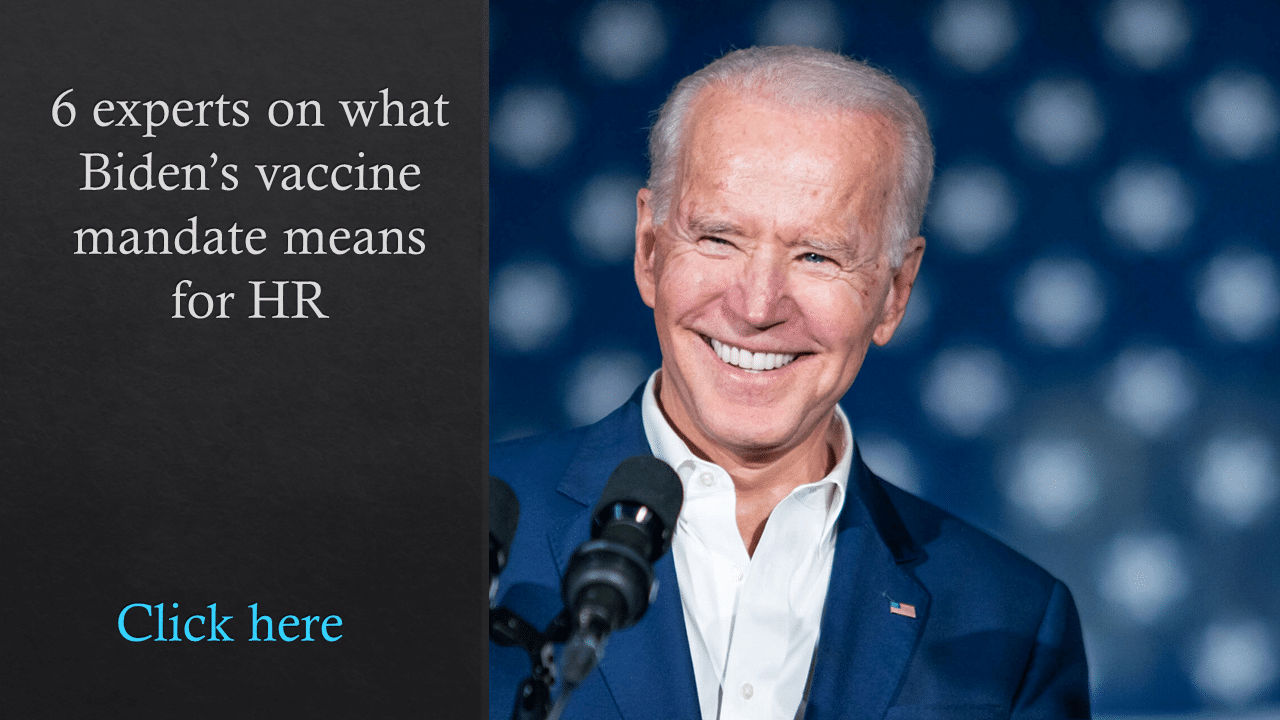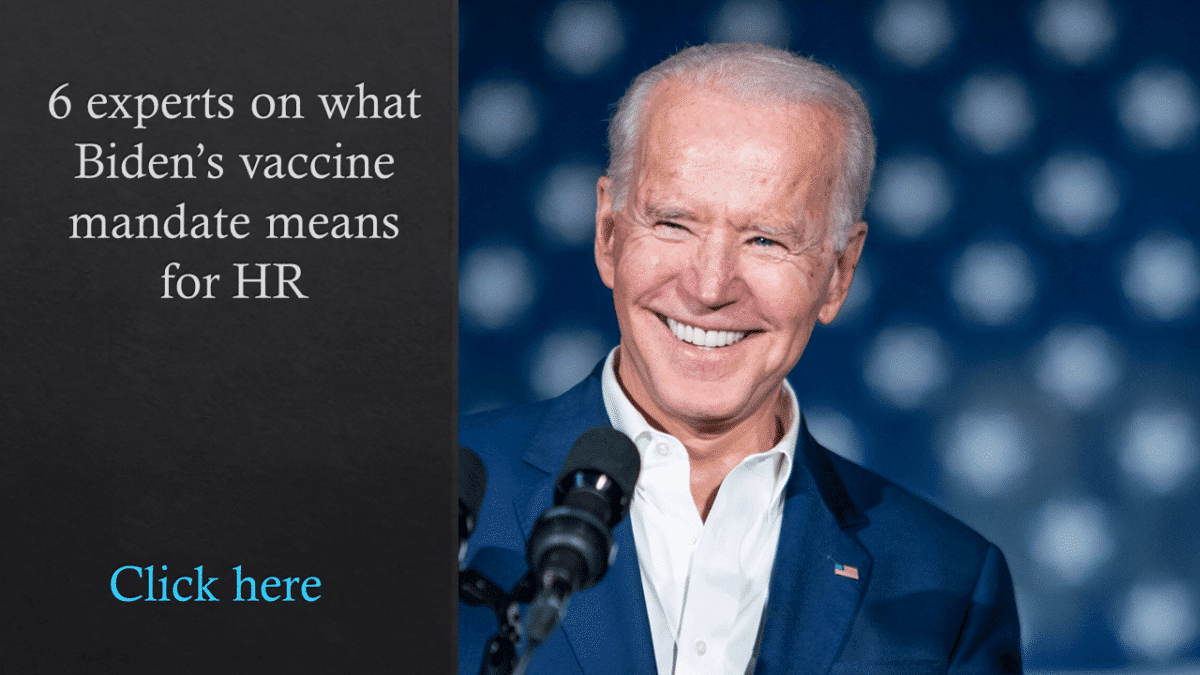Travel is getting back to normal on Southwest Airlines this week, after several days of cancellations that sidelined thousands of passengers—and highlighted one of HR’s newest COVID-19 challenges.
Over the last week, Southwest halted more than 2,000 flights, with leadership pointing to weather, air traffic control issues and staffing problems. However, news reports, fueled by claims from conservative lawmakers, hinted that the pilots’ union had actually staged a work stoppage in protest of President Joe Biden’s recent vaccine mandate executive order.
Announced last month, the rule will require employers with more than 100 employees to mandate vaccines or weekly COVID-19 testing. The president also signed orders requiring most federal employees and contractors, as well as healthcare workers across the country, to be vaccinated against COVID-19. The Occupational Safety and Health Administration on Tuesday issued the text of the proposed rule, which needs to be approved by the Office of Management and Budget before being finalized.
At Southwest, while union leadership denied members were carrying out a work stoppage in response to the new rule, it did ask a judge last Friday to block the airline from enacting the vaccine mandate and other policies. And earlier this week, Gov. Greg Abbott (R) of Texas, where Southwest is headquartered, turned the controversy up a notch by issuing his own executive order barring “any entity” in the state from enforcing a vaccine mandate; Southwest leadership has since said the company will comply with federal guidelines, despite Abbott’s order.
The dustup at Southwest demonstrates that HR leaders and employers are being challenged to manage the quickly evolving vaccination issue within their own workplaces, experts say.
Related: Mandating vaccines? How tracking tech can help with the next step
According to Erik Samdahl, vice president of marketing at the Institute for Corporate Productivity (i4cp), in many cases employers had already begun to roll out vaccine policies before the announcement of the federal proposal. Since the emergence of the Delta variant—but prior to the Biden administration’s executive order—i4cp saw a sharp increase in employer vaccine mandates. In fact, as of late September, an i4cp survey found that 48% of companies had implemented or were planning to implement mandates for all on-site workers, with another 23% considering them.
Related: Everything HR needs to know about Biden’s vaccine mandate
“Of course, the mandates pose significant complexities,” Samdahl says, most notably: How do you enforce them? Do you shift the unvaccinated away from frontline roles? Do you fire them? Can you operate with a reduced staff when so many companies are already struggling to fill roles?
“In many ways, it’s a no-win scenario, but it’s clear that many companies are swinging in the direction of health and safety, and more urgency to bring an end to the pandemic—even if it means losing employees and disrupting operations,” Samdahl says. “What we’ve recommended to employers, first and foremost, is that they listen to what their employees are saying, through surveys or other mechanisms.”
He adds that some employers are finding success by saying something along the lines of, “The vast majority of you say you don’t want to work next to unvaccinated coworkers,” and using that as the foundation to communicate why they’re implementing a given policy.
“That’s not going to win over everyone, especially in this political climate,  of course,” he adds.
of course,” he adds.
Regarding the workplace vaccine mandates themselves, a survey conducted by Willis Towers Watson in August polled nearly 1,000 companies that together employ almost 10 million people. Key findings include that by the fourth quarter of 2021:
- 52% plan to have vaccine mandates by the end of the year (including 21% that already do)
- 78% plan to track employees’ vaccination status (55% already do)
- 17% percent are considering health insurance premium rewards or surcharges to encourage vaccination (2% already do)
“The Delta variant has made employers take new actions to keep their workers—and workplaces—safe and healthy. We expect even more employers to institute vaccine mandates,” with the Pfizer vaccine now having full FDA approval, says Jeff Levin-Scherz, M.D., population health leader at Willis Towers Watson.
But “this is not an easy situation for employers to navigate,” he says. For example, new policies around tracking vaccination status can improve safety but also bring additional administrative requirements. At the same time, employers are continuing efforts to encourage vaccination and communicate regularly with employees, he says.
Vaccine mandates are creating an added layer of complexity to many companies’ return-to-office plans, says Benjamin Granger, an organizational psychologist and head of employee experience advisory services at Qualtrics. The organization offers a tech platform that gathers information about employees’ vaccination status, as well as conducts daily symptom checks.
“We know from our research that vaccine mandates are a polarizing topic among employees,” Granger says. “How businesses listen to and communicate with their people will be the key to successfully rolling out these new policies and preventing unwanted turnover.”
He offers four pieces of advice to help put employees—not processes—at the center of a vaccine rollout strategy:
- Listen and lead with trust: It would be a huge mistake for an organization to simply make a decision on a vaccine policy and roll it out, he says. It is essential that companies understand how their employees feel about vaccine mandates, meet them where they are with empathy and bring them along as they implement new policies.
- Communicate clearly and act swiftly: Employers that create open lines of communication, ask employees about their experiences and make adjustments based on that feedback will create a culture of mutual trust and respect.
- Make it easy to comply: Companies must ensure that the process for complying with vaccine mandate policies is as simple and seamless as possible—for example, enabling employees to engage with whatever technology is most convenient for them (email, SMS, QR codes, etc.).
- Design for agility: With COVID-19, the situation can change quickly, making some policies obsolete. Organizations should plan ahead for this possibility and be transparent with employees that the company’s guidance could change in the future, he says.
“Simply put,” Granger says, “employers that take the time to implement policy changes with empathy and understanding will have a strong competitive advantage when it comes to attracting and retaining their employees.”

